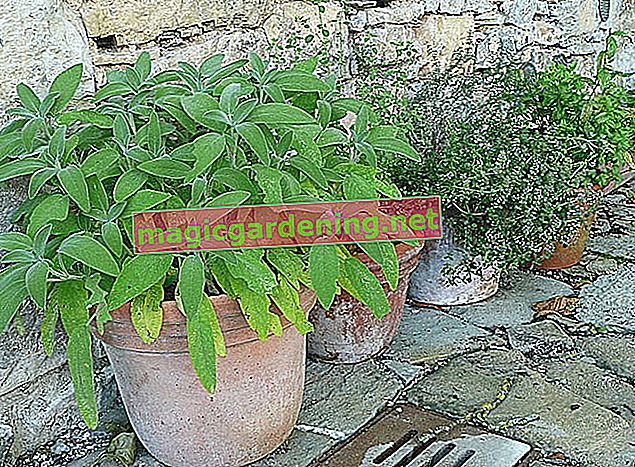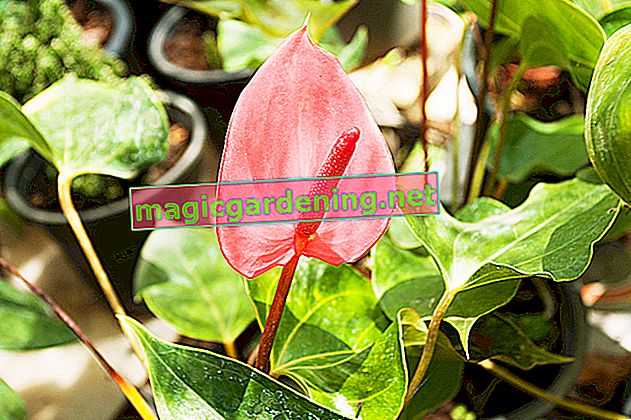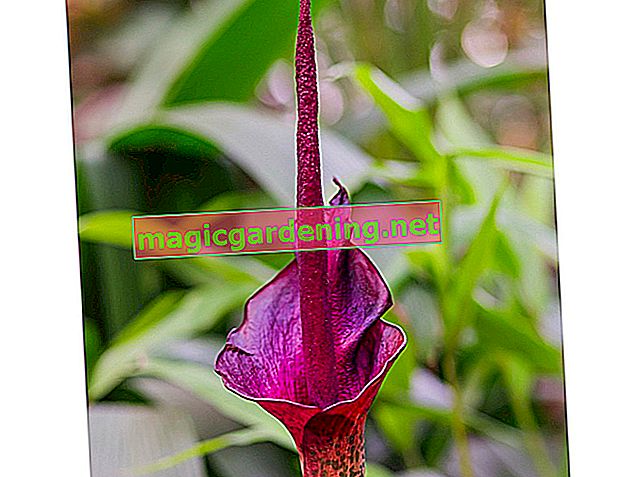
origin
The genus of pitcher plants (Nepenthes) contains 92 species that are only found in a few very limited mountain areas worldwide. Their main distribution area extends over the tropical climatic zones. Here the plants climb heights of over 3,500 meters.
also read
- The flower of the pitcher plant (Nepenthes)
- Caring for the dried up pitchers of the pitcher plant
- Is it necessary to feed a pitcher plant?
There are highland species that are exposed to temperatures of 30 degrees Celsius during the day and thrive at 15 degrees Celsius at night. Lowland species can cope with constant temperatures between 25 and 35 degrees Celsius all year round.
Pitcher plants have been cultivated since the 19th century. There are now more than 200 hybrids that are more robust and easier to care for than the wild forms. These ornamental forms arose from crossings of species that occur in the middle highlands. These representatives include Nepenthes veitchii, Nepenthes ventricosa or Nepenthes fusca.
blossom
Pitcher plants grow dioecious. There are male and female specimens. The flowers sit tightly together in panicles or clusters. With their 15 to 100 centimeters long flower stalks, they protrude far beyond the plant. Each flower consists of four, rarely three petals.
Male and female flowers appear between March and September. They differ in their smell. The male flowers give off an aroma that smells of excrement, which is supposed to attract insects as potential pollinators. Female flowers are odorless. Pitcher plants bloom extremely rarely in indoor culture.
Continue reading
leaves
These carnivorous plants develop special leaves that are shaped like pots. A sheet is made up of three parts. A leaf-shaped part has emerged from the actual leaf base, which appears leathery and coarse and is lanceolate to elongated or egg-shaped.
The leaf base is traversed by a raised central rib that extends beyond this leaf structure and ends at the base of the can. According to theories, this leaf shape emerged from the petiole. In older specimens, this central rib takes on the function of a tendril. With their help, the plants climb up the surrounding vegetation. In young plants, these leaf shapes do not have a climbing function. The actual leaf blade is transformed into a pitcher that serves as an insect trap. They are covered by a lid.
growth
Pitcher plants are carnivorous plants. They do not actively catch their prey. Their traps are colored at the opening and equipped with nectaries so that the insects are attracted by scents and colors. A toothed jug edge shows the insects the way into the jug, from which it is difficult to get out again. The inside of the jug is covered with a layer of wax that the insects cannot hold onto. The traps are tapered from the belly to the opening so that the prey cannot easily escape.
The lid is immovable and serves as a protection against rainwater and a washout of the prey by water flowing in. The jugs contain a digestive fluid that is highly acidic. Their pH is around three. Numerous enzymes ensure that the prey is completely decomposed within two days. A pitcher trap has a three month survival period before slowly dying off.
Almost all pitcher plant species develop two different types of trap. While the young plants form round bottom jugs arranged in a rosette, mature plants have air or hanging jugs. The latter are lighter in color than the ground pitchers and appear elongated. In the case of the floor pitchers, the leaf stem, which does not yet have a climbing function, is aligned to the front of the pitchper. This type of trap has a clear wing bar on the front, which is missing on the air cans. In this shape, the handle is directed backwards and is used for climbing.
Edible
Pitcher plants are not poisonous. Two types are used in Malaysia for the preparation of snacks. People use the traps of Nepenthes ampullaria and Nepenthes mirabilis, which are eaten filled with rice. In traditional medicine, the plants have long been used to cure various diseases. The sap has positive effects on bladder problems, coughs or eye diseases and skin infections. The digestive juice of the traps is used to prepare refreshing beverages.
Offshoot
The carnivorous plants can be successfully propagated using cuttings. Cut a cutting between four and six inches from the trunk between two leaves. The mother plant then appears headless. It develops new shoots within the next few days. Put the cuttings in a moist and nutrient-poor substrate. Put a plastic bag over the planter to keep the humidity constant. To avoid mold growth, you should remove the bag for a short time every day.
It takes a few weeks for the first roots to develop. Then you can repot the cutting into a larger container. Use a substrate specially designed for carnivorous plants. Root formation can be accelerated if you first place the offshoot in a vessel filled with decalcified water and then put it in orchid soil.
You should pay attention to this when cutting cuttings:
- Mother plant should be well developed
- prune during the growth phase in summer
- use a sharp knife
Continue reading
Which location is suitable?
These plants have special requirements for the location, with highland species being adapted differently than lowland species. The latter thrive when the humidity is at least 60 percent. Highland species require a humidity of 90 percent. Pitcher plants need temperatures between 20 and 30 degrees Celsius all year round, depending on the species. Highland species are dependent on temperature fluctuations. They thrive in daytime temperatures of 30 degrees Celsius and night temperatures of 15 degrees Celsius. A sunny place promotes the growth of all representatives within this genus.
What soil does the plant need?
Carnivores need a special substrate that is adapted to the needs of the carnivorous plants. They prefer nutrient-poor soil as they absorb enough nutrients through their prey. With expanded clay, (€ 17.50 at Amazon *) perlite (€ 32.90 at Amazon *) or coconut fibers, you can improve the permeability of the substrate.
This substrate is suitable for pitcher plants:
- Mixture of sand and peat
- Mixture of white peat with ten percent quartz sand each (€ 14.90 at Amazon *) and perlite
- Orchid soil
- Peat moss
- coarse peat with charcoal and pieces of bark
In the greenhouse
For pitcher plants, cultivation in the greenhouse is recommended, as they do not grow well under indoor conditions. A greenhouse ensures a consistently high level of humidity. It buffers temperature fluctuations better. Be sure to ventilate the greenhouse regularly. This will prevent mold from forming.
Pitcher plant in the pot
Pitcher plants are suitable for cultivation in hanging baskets. Here you have to pay attention to regular spraying, because the humidity in the room is not sufficient for healthy growth. Moisten the entire plant with rainwater several times a day and submerge the planter in water every three to four days. Make sure you have a bright location.
balcony
The carnivores can be placed on the balcony in summer. Depending on whether you have a highland or lowland species, you have to consider the outside temperatures between day and night. In southern regions, the lowland species can also be left outside at night. If the temperatures drop sharply at night, you should bring these plants indoors in the evening. Highland species are grateful for the temperature fluctuations.
Propagate pitcher plant
The carnivorous plants can be propagated via seeds. Since the plants in indoor culture extremely rarely bloom, the plants do not reliably form seeds. You can get these from specialist dealers. Make sure the seeds are fresh. The germination capacity does not last long. Therefore, they have to be scattered on moist substrate within a short time after being picked from the fruit stands. Propagation via cuttings is more successful and easier.
Continue reading
sowing
Put a substrate mixture of peat, peat moss, cellulose and coconut in a growing container. Scatter the seeds as thinly as possible on the earth and make sure that they are not covered by the substrate. The light germs require a high level of humidity. Cover the nursery pot with a transparent film. Remove the foil every day to prevent the seeds from going moldy. The vessels must be in a bright and warm place. It takes several months for the seeds to germinate.
Cut the pitcher plant correctly
The carnivores are easy to cut. They form new shoots within a short time after a cut. If the plants develop too long and thin shoots, pruning makes sense. A strong pruning ensures that the plant branches out and grows compactly at the interface. You can regularly remove completely dried out leaves and shoots. As soon as a jug has died, it is removed at its base. The leaf base should be left on the plant when it is still green.
Continue reading
Water pitcher plant
As marsh plants, the plants need a constantly moist substrate. Make sure you have regular watering, which is stronger in summer than in winter. Use rainwater. Tap water should be boiled and poured over a coaster. Prevent waterlogging so that the sensitive roots do not rot. If you water too little, the pitchers will wither.
Continue reading
Fertilize pitcher plant properly
The carnivorous plants do not need to be fertilized. They get their nutrients from the prey they catch with their pitchers. Even if the prey catch is small, the vitality of the plants is not impaired. They feed on residual nutrients from the substrate or the leaves.
Overwinter
The species fall into a dormant state in winter, where growth stops. However, the temperatures do not differ between summer and winter. Highland species require a temperature fluctuation between day and night even in winter, while lowland species and hybrids need constant conditions. In winter you can reduce the amount of water. Make sure that the substrate does not dry out. The lack of brightness is the biggest problem in winter. Give your pitcher plant an additional source of light in winter.
Continue reading
Repot
Pitcher plants should be repotted as soon as their roots have completely grown through the substrate. There are fast growing species that should be transplanted annually. Slow-growing species need a larger planter about every two to three years.
Repot the plant in summer when the growth phase is in progress. At this time the plant is strong enough to adapt to the new substrate without any problems. Choose a planter that is four to six inches larger in diameter than the old pot.
Continue reading
Dried up
Pitcher plants shed their used traps after several months. With good care and location conditions, it can take up to a year for a trap to dry up. You can cut off the dried out parts of the plant or leave them on the plant until they fall off by themselves.
If the cans dry up before opening or if no cans are formed, the site conditions are not optimal. This phenomenon indicates that the humidity is too low or the location is too dark. Put a large transparent glass over the plant to keep the humidity at a consistently high level. Put the plant in a bright place.
Diseases
Nepenthes species are resistant to diseases. Care errors or incorrect site conditions lead to stress and disturbances that impair growth. Root rot and mold formation are the most common phenomena caused by waterlogging. It is important to act quickly so that the plant does not suffer much damage. Remove affected parts of the plant and damaged roots before planting the plant in fresh substrate.
Tips
The jugs are naturally filled to a third with liquid. The plants are often sold in specialist shops or online shops without digestive fluid. At home, immediately fill the jugs with decalcified water or rainwater. The plants then release enzymes into the water through glands in the lower part of the pitcher, so that a new digestive fluid is produced in this way.
Pests
Pitcher plants can be attacked by aphids. Isolate the plant to prevent the pests from spreading. A commercially available remedy against aphids provides a quick remedy. Alternatively, you can expose beneficial insects to the plant. Thrips infestation can be combated in a similar way. These pests lead to silvery iridescent spots on the upper side of the leaf. On the underside, they leave their droppings, which appear in the form of dark dots the size of a pinhead. It can be easily wiped away with your finger.
sorts
- Nepenthes ampullaria: Small, spherical pitchers with a diameter of seven centimeters. Climbs up to ten meters. Suitable for high terrariums.
- Nepenthes mirabilis: subshrub whose trunk lignifies over time. Floor jugs up to five centimeters long, hanging jugs up to 16 centimeters tall.
- Nepenthes macfarlanei: For shady locations.
- Nepenthes aristolochioides: pitchers yellowish-green with red spots. Reminiscent of pipe wind flowers.
- Nepenthes alata x ventricosa: Hybrid of highland species. Develops 15 centimeter jugs. Suitable for beginners. Can handle low humidity.
- Nepenthes inermis x ventricosa: Hybrid of highland species. Funnel-shaped pitchers up to 15 centimeters long.








